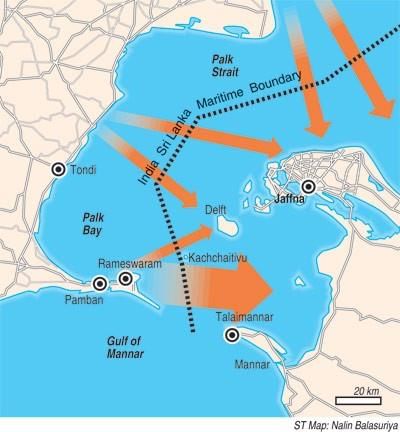UPSC Exam > UPSC Notes > Current Affairs & Hindu Analysis: Daily, Weekly & Monthly > The Hindu Editorial Analysis- 11th April 2024
The Hindu Editorial Analysis- 11th April 2024 | Current Affairs & Hindu Analysis: Daily, Weekly & Monthly - UPSC PDF Download

Katchatheevu demands thinking outside the box
Why in news?
Recently, during the No Confidence debate in the Parliament, Prime Minister Narendra Modi made a reference to the island of Katchatheevu.
What is the history of Katchatheevu Island?
- Location: Katchatheevu is an uninhabited off-shore island located in the Palk Strait, which originated from volcanic eruptions in the 14th century.
- It measures not more than 1.6 km in length and slightly over 300 m wide at its widest point.
- Geographically, it is positioned northeast of Rameswaram (India) and southwest of Jaffna (Sri Lanka).
- The island hosts the St. Anthony Church, a Catholic shrine constructed in the early 20th century, which stands as the sole edifice on the island.

Overview of the Maritime Boundary Agreement
The Maritime Boundary Agreement addresses the historical fishing practices between Sri Lanka and India in each other's waters. While conflicts were absent for a long time, issues arose upon the signing of agreements in 1974-76.
- Historical Fishing Practices: Fishermen from both countries have traditionally engaged in fishing activities in each other's waters without disputes.
- Emergence of Issues: Problems arose when formal agreements were established between the two nations during 1974-76.
- 1974 Maritime Boundary Fixation: The 1974 agreement aimed to define the maritime boundary specifically in the Palk Strait region.
- Sovereignty and Control: According to the 1974 Agreement, each country was granted sovereignty, exclusive jurisdiction, and control over waters, islands, continental shelf, and subsoil on their respective sides of the boundary. However, navigational rights for vessels of both nations were preserved.
1976 Agreement between India and Sri Lanka
- Both Parties agreed to uphold the rights of navigation in their territorial sea and exclusive economic zone as per their respective laws, regulations, and international law.
- The agreement established the international maritime boundary between India and Sri Lanka, a decision made without consulting the Tamil Nadu State Assembly.
Overview of the Conflict
- Indian fishermen have been encroaching into Sri Lankan waters in search of a more abundant catch, leading to fish depletion in the region.
- The depletion of fish and aquatic life in the Indian continental shelf has escalated the problem.
- Modern fishing methods, such as the use of harmful fishing trolleys, have been exacerbating the harm to marine life and the ecosystem.
- Sri Lankan authorities have been making arrests and even resorting to violent measures to protect their maritime boundaries from poaching and to safeguard the livelihoods of local fishermen.
- Despite both sides agreeing not to use force, the conflict persists, with instances of violence still occurring.
- In 2009, Sri Lanka significantly bolstered its maritime security in the Palk Strait to prevent the resurgence of Tamil insurgents in the country.
Understanding Tamil Nadu's Stance on Katchatheevu Island
- Tamil Nadu asserts historical control over Katchatheevu due to the Ramnad zamindari's past governance and the traditional fishing rights of Indian Tamil fishermen.
- The island was transferred to Sri Lanka without consulting the Tamil Nadu State Legislative Assembly.
- In 1991, the Tamil Nadu Assembly passed a resolution urging the retrieval of Katchatheevu.
- During 2008, Tamil Nadu filed a legal petition, contending that ceding Katchatheevu would require a constitutional amendment.
- In 2012, Tamil Nadu escalated the matter to the Supreme Court, seeking swift action following the increased apprehension of Indian fishermen by Sri Lanka.
India's Position on the Island Dispute
- The Indian government's stance is that no Indian territory was conceded or sovereignty relinquished concerning the disputed island.
- As per the agreement, the island is situated on the Sri Lankan side of the India-Sri Lanka International Maritime Boundary Line.
- High-level discussions have taken place between the Indian government and Sri Lanka regarding this matter.
- The case is currently awaiting a decision in the Supreme Court of India.
The document The Hindu Editorial Analysis- 11th April 2024 | Current Affairs & Hindu Analysis: Daily, Weekly & Monthly - UPSC is a part of the UPSC Course Current Affairs & Hindu Analysis: Daily, Weekly & Monthly.
All you need of UPSC at this link: UPSC
|
63 videos|5408 docs|1146 tests
|
Related Searches




















